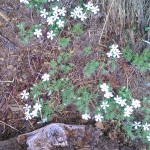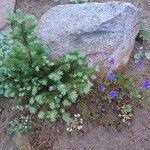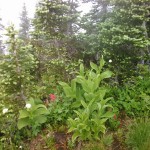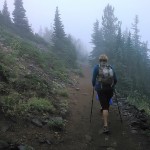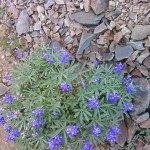 Mt. Rainer is revered for its extensive wildflower displays. During the summer months when the meadows are in peak bloom a hike to Dege Peak can yield sightings of approximately 20 varieties of blooms on our 4.2 miles out and back journey from the Sunrise parking lot. Depending on who you ask, this peak, named after Tacoma businessman, James Dege, may be pronounced to rhyme with “leggy” or “reggae.”
Mt. Rainer is revered for its extensive wildflower displays. During the summer months when the meadows are in peak bloom a hike to Dege Peak can yield sightings of approximately 20 varieties of blooms on our 4.2 miles out and back journey from the Sunrise parking lot. Depending on who you ask, this peak, named after Tacoma businessman, James Dege, may be pronounced to rhyme with “leggy” or “reggae.”
After months of hotter than normal temperatures, we were greeted at the mountain by heavy fog and mist, a welcome respite. The weather didn’t lend itself to expansive, “Sound of Music” style panorama camera shots, but it did isolate the blooms and showcase them individually, bedecked in crystalline dewdrops. The subtle fragrance of the plants was muted by the smell of moisture reaching long-dry earth.
Amongst water-laden grasses and boughs, we glimpsed lupine and alpine asters, magenta paintbrush and the large and leafy false hellebore. Rosy spirea and pasqueflower seedheads dominated the landscape, along with smooth mountain dandelion. The alpine fir and cedar along the path presented themselves in dense clumps, known as “tree islands.”
On a clear day, this family-friendly hike presents expansive views over an 800-foot elevation gain, to the 7,006 high point at the summit. Hikers can take in views of Goat Rocks, Glacier Peak, Mount Stuart, Mount Daniel, and Mount Adams. The trail runs above the road to Sunrise which can create traffic noise. It was hardly noticeable during our excursion; due to the fog insulation and repeated refrains of “are we there yet?” from the youngest member of our party.
The most physically challenging portion of the hike is the climb from the parking lot to where the trail branches, a distance of about .2 miles. We were greeted at the outset by a mole, who shoved dirt over the entrance to his burrow at the sight of us – his home nestled amongst broadleaf lupine and subalpine daisy. The path is initially wide and talc-y with periodic informational signs covering everything from native peoples to why a fed animal is a dead animal. Along the way, there were several viewpoints (dew points?) that no doubt afford tremendous views in better weather. Along with wildflowers and area peaks and lakes, the mountain is home to many species of wildlife.
Once we reached the summit we encountered a mildly wary marmot and a curious chipmunk, as well as a pile of dying wildflowers that someone had picked and placed on the highest boulder. Feeding wildlife, tromping through fragile alpine meadows and picking wildflowers are fineable offenses for obvious reasons, and visitors are asked to leave no trace.
After a lunch of turkey sandwiches, apples, and cheese, we headed out briskly, our footsteps showing lighter tracks in the darker, dampened trail soil. A hot cup of cocoa from the snack bar at Sunrise proved restorative for our 6-year-old, and we drove home grateful to have seen the wondrous wildflowers in a different light.
Typically, peak wildflower season at Mount Rainier runs from mid-July to mid-August. Check out local forecasts and mountain webcams for the latest on area weather. For lodging near these wildflowers click here.
- phlox
- small flower penstemon1
- false hellabore
- smooth mtn dandelion
- dewey lupine

